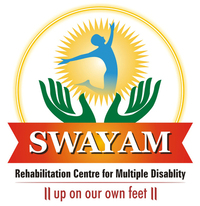

In a past decade, through center-based therapy and rehabilitative services, Swayam has made a sincere effort to minimize the physical, psychological and financial stressors posed on the families of children with cerebral palsy. Children with cerebral palsy require long term rehabilitation and frequent follow ups with multiple professionals. The process the rehabilitation of these children, which primarily centre-based, can be extremely stressful and challenging due to multiple factors like limited financial resources, lack of family support, long hours of travelling to reach the therapy centers, poor public transportation services for the individuals who are non ambulatory. Therefore, when a child with disabilities is born the families require a robust support system and guiding light to help them understand how to take care of children.
Therefore, at this milestone in their journey, Swayam has taken a new leap to pro-actively adapt with a more family-centric model of rehabilitation as they are launching a project namely ‘Home-based Rehabilitation of children with Cerebral palsy’ for the children residing in and around Thane city.
Experiences and observations at Swayam and the results of the study titled 'Home Based Rehabilitation for children with Cerebral Palsy: A Needs Assessment' (Deolalkar, 2010) indicated that the children with cerebral palsy have certain capabilities and even intrinsic strengths which can be used to overcome their limitations that have resulted because of their impairment. The caregivers have accepted the condition of their children with cerebral palsy and are determined to pursue rehabilitation services if there has to be any positive changes in their child and his/her development. But at the same time non-accessibility of the services and lack of instrumental support (help in day to day working) to the caregivers impedes the further efforts that have to be done towards rehabilitation of the child. The study threw light on several critical factors that hinder the success within the totally ‘Centre Based Therapy’.
The various intervention approaches incorporated in the treatment of Cerebral Palsy are aimed at reducing the associated effects of brain damage and developing motor milestones, achieving independence in activities of daily living, prosthetic and orthotic rehabilitation, and cognitive enhancement via special education. An essential aspect of rehabilitation of children with Cerebral Palsy is correct handling and postures which should not be restricted to therapy sessions in the centre based therapy only, if the child is to benefit from the services aimed at improving his/her condition. These should be carried over and incorporated into daily activities (bathing, dressing, feeding etc.), and the daily routines of the child, by himself/herself if possible. It then becomes essential according to us that the care givers are well versed with the correct ways of handling and correct postures, specific to the needs of their child. Also they should be competent in simple exercises that can help to prevent deformities and foster the child’s development (Piggot et al., 2002).
Parents’ psychological and physical health is of prime importance, for them to be better equipped to deal with the extra demands placed on them by their child’s condition. The children and their caregivers experience strain as traveling long distances to Therapy Centers and hard work involved in these exercises saps the energy from these drained bodies. The caregivers of children with older and acute Cerebral Palsy also experience ailments like pain in back, spinal cord, ribs and surrounding muscles due to carrying their older and physically grown child during their daily care taking and trips to Therapy Centers and special schools (Deolalkar, 2010).
Government institutions are very limited and meager (only one) in Thane city and its surrounding areas with only focus on some different disabilities like mentally retardation and hearing impairment. Private institutions are very few compared to the numerical strength of these children with disabilities, and expensive and exorbitant. Charitable institutions are scarce and are limited to some sections of society depending upon caste, religion, which in some way tends to regulate service provision.
Taking into consideration the parental stress and the need for ‘centre- based therapy’, one has to think about the appropriate solution which will provide comfort to parents as well as enhance the quality of life of the children with Cerebral Palsy. Therefore there is a need for an alternative solution such as home-based rehabilitation services so that the children make optimum utilization of rehabilitation programs within the existing resources, enhance their strengths and make their life more independent and meaningful.
The study done by Deolalkar, 2010 highlighted the fact that caregivers gave preference to the home based solutions for their wards, in the comfort of their home environment. This is further backed by the fact that for the children with severe Cerebral Palsy, “home” is the setting of choice for receiving services (as the child lives, develops and interacts in home environment), making it imperative for the services to extend beyond the institutional walls.
We, at Swayam were therefore drawn towards the need for developing parents’ coping capabilities and their home based management skills, so that they become active and competent partners in the rehabilitation of their child. Thus, we intend to develop a model of home based rehabilitation for the child with disability and his/her family that is based on the theoretical framework of ‘Strengths Perspective’ (Saleebey 2002) and ‘Empowerment Model’(Croft and Beresfort 1994). Strengths Perspective is a belief that no matter how subordinated, marginalized and oppressed individuals and communities may appear, people individually and collectively do possess a kind of resilience and vitality, and tools for the realization of their hopes and dreams. These tools may be damaged, hidden or dormant but whatever their condition, they are awaiting discovery and/or expression. The Empowerment Model argues that a participative approach is valuable because people want and have a right to be involved in decisions and actions taken in relation to them.

